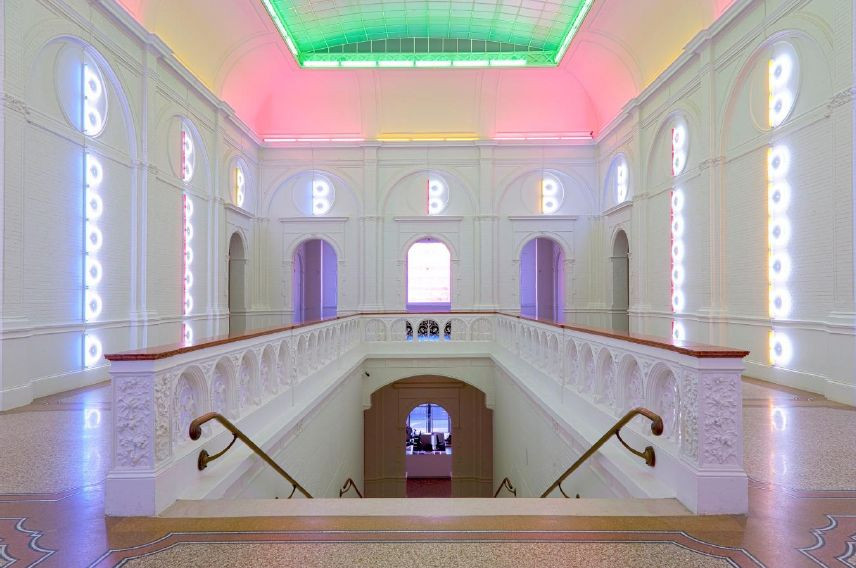stedelijk museum amsterdam acquires iconic dan flavin installation
News — Jul 2, 2012
The Stedelijk Museum Amsterdam is delighted to announce the purchase of an iconic installation created in 1986 by Dan Flavin especially for the museum's historic building. Reinstalled in 2011 and presented as part of Temporary Stedelijk 2, the installation will be on view next as part of the reopening of the Stedelijk Museum on September 23, 2012. This major acquisition has been made possible by support from a private donor, Mondriaan Fonds and the Titus Circle of the Vereniging Rembrandt.
A special digital publication produced by the Stedelijk Museum in conjunction with the acquisition will be available online.
In 1986, Stedelijk Museum director Wim Beeren invited American artist Dan Flavin (1933–1996) to create a large-scale installation for the upper hallway surrounding the grand
staircase of the museum. One of the most significant and influential artists of the 20th century, Flavin is renowned for works incorporating fluorescent light, his primary material from 1963 until his death in 1996. His remarkable fluorescent light installations and their distinctive relationship with architectural space are viewed as integral to the emergence and foundations of Minimal art in the 1960s.
This major acquisition is a single installation comprising two parts. Flavin made untitled (to Piet Mondrian through his preferred colors, red, yellow and blue) and untitled (to Piet Mondrian who lacked green) 2 in dialogue with the architecture of the historic museum building, specifically the hallway above the museum’s famous grand staircase. The result of a close collaboration with the artist's estate and executed in the same space where it had been originally presented in 1986, the installation at the Stedelijk is one of the few site-specific works recreated after the artist’s death.
Flavin’s installations often reference the history of modern art: untitled (to Piet Mondrian through his preferred colors, red, yellow and blue) pays tribute to Piet Mondrian, whose abstract paintings used the primary colors red, yellow and blue – colors associated with De Stijl. The second part, untitled (to Piet Mondrian who lacked green) 2, is a supplement to this first work. Although Mondrian repudiated the color green because it is not a primary color in pigment, Flavin frequently used it, since light is essentially made up of red, blue and green. Flavin’s use of green thus references Mondrian’s palette but translates it into a contemporary material.
The installation joins two important artworks by Flavin dating from the 1960s and early 1970s in the Stedelijk Museum collection. These works – “monument” for V. Tatlin (1969) and untitled (to Barnett Newman to commemorate his simple problem, red, yellow, and blue) (1970) – honor other artists in the museum's collection. In its acknowledgement of modernism and abstraction, Flavin’s installation creates a unique bridge between pre-1940s modernism and the work of his late twentieth- century contemporaries.
The discussion that led to the recreation of this installation was initiated with the Estate of Dan Flavin by former Stedelijk Museum director Gijs van Tuyl in 2008. Upon assuming directorship in 2010, Ann Goldstein continued the discussion and realized the reinstallation in 2011 as part of Temporary Stedelijk 2. Goldstein states, “We are thrilled that this extraordinary work is now part of the museum's permanent collection. One of the very few extant monumental works by Flavin that can actually be re-executed in its original site, its successful reinstallation in 2011 brought an extraordinary work of art back to the public and highlighted the Stedelijk's significant history with the artist. Living with it again at that time prompted the desire to try to acquire the work. It now joins a very special collection and, in so doing, extends the Stedelijk’s history of acquiring works made especially for the
Stedelijk Museum Amsterdam is supported by: Main Sponsor
museum’s own architecture. We are honored by the tremendous generosity of the Mondriaan Fonds, the Vereniging Rembrandt and a private donor who made it possible for us to ensure that this work remains available for future generations.”
When the Stedelijk Museum reopens in September, the majority of the renovated historic building will be devoted to the presentation of its renowned collection. The ground floor will primarily feature art of before the 1950s, as well as the acclaimed collection of applied, industrial and graphic design. Work from after the 1950s to the present will be on view in the second floor galleries.
A special online publication prepared in celebration of the new acquisition will be available to read and download from the Stedelijk Museum’s website. Illustrated with images of both the original 1986 installation and the 2011 reinstallation, it features essays by Stedelijk curator Bart Rutten and curatorial intern Britte Sloothaak; an interview with former Stedelijk curator Dorine Mignot, who worked closely with Flavin throughout the production of the original installation in 1986; and a previously unpublished letter drawn from the museum’s archives in which Flavin writes about the work.
The Stedelijk Museum gratefully acknowledges the Estate of Dan Flavin and David Zwirner for their support.

